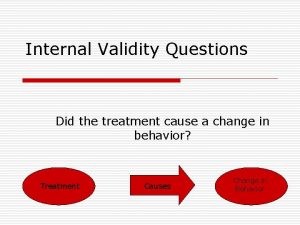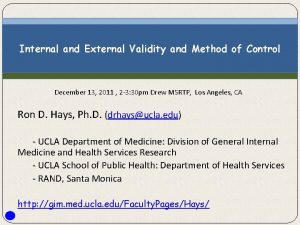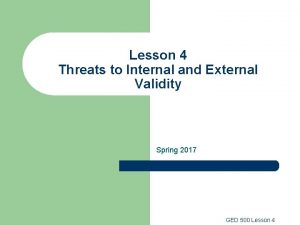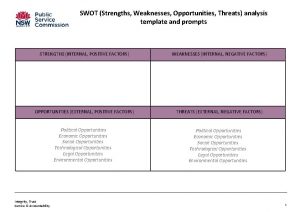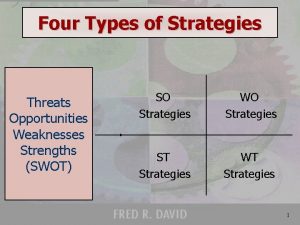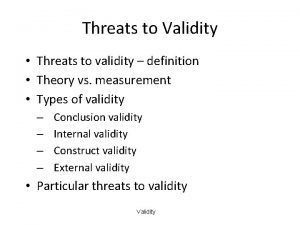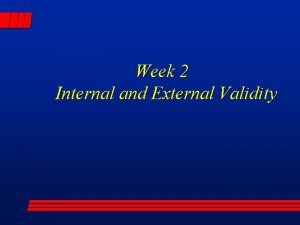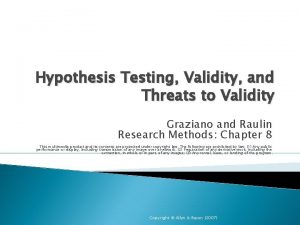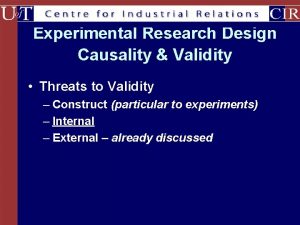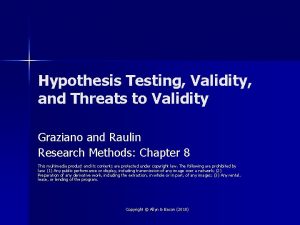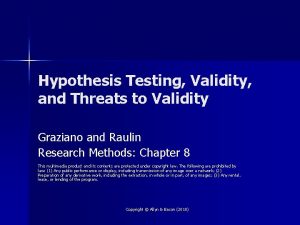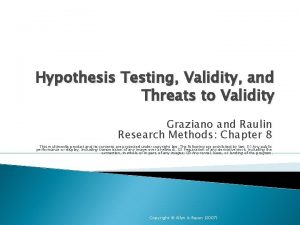Internal Threats to Validity 1 History of the

















- Slides: 17

Internal Threats to Validity 1. History of the subject. 2. Maturation of the subject. 3. Instability of the subject. 4. Testing effects. 5. Instrumentation 6. Regression artifacts. 7. Selection. 8. Experimental mortality. 9. Selection‑Maturation interaction.

1. History of the subject. • History of the subject. Any event that occurred other than the independent that may have produced the result in the independent variable. It may be anything that happened during the intervention or outside the intervention. This occurs when an event other than the treatment changes the subject on dimensions relevant to the dependent variable. For example, the dependent variable were depression and an event outside of treatment changed that relieved the depression the change attributed to the treatment would be invalid.

2. Maturation of the subject. • Maturation of the subject. This refers to any process that may occur over time. It differs from history in that it is systematic in terms of time ‑‑ growing older, getting smarter, getting bigger, using up resources, getting tired, habituating, getting more concerned, getting less concerned, and etc. If two groups of subjects, say first grade school children and third grade school children were assigned to brush their teeth with "Crest" and "Colgate" respectively for six months and assessed pre and post the "Crest" group might look bad because children loose their "baby teeth" about six years of age. Consequently, if number of teeth at pretest and number of teeth at posttest were used as the dependent measure erroneous conclusions would be drawn.

3. Instability of the subject • 3. Instability of the subject. The state of the subject may change periodically (or randomly). For example, schizophrenic clients seem to have episodes where at times they are more lucid than others.

4. Testing effects. • Testing effects. The effects of memory of the first test might have on taking the second test. The reduction of test anxiety ‑‑ or increasing test anxiety. The pretest can cue the subject to attend to the treatment. For example, if the pretest asks the subject about his or her level of stress and the treatment is designed to alleviate stress the subjects who were asked to assess their level of stress might be more attentive to the treatment and therefore be more influenced by the treatment.

5. Instrumentation • Instrumentation. The measuring device may be unreliable. This is particularly true when raters are the measuring device. Raters might improve their accuracy over time because of practice or diminish accuracy because of boredom.

6. Regression artifacts. • Regression artifacts. There is a tendency for extreme scores to move toward the mean over time. For example, when clients enter treatment they are probably "at their worst" and they are likely to "get better" regardless of what happens to them.

7. Selection. • Selection. Subjects can be selected and a systematically biased manner. For example, if the subjects of two different psychiatric hospital wards are compared there is the possibility that the clients of one ward might be more chronic than the other ward.

8. Experimental mortality. • Experimental mortality. When subjects withdraw from the treatment it may be that they do so because the treatment is not "working" for them. This will bias the study because the only the clients who remain will be tested at the posttest and the treatment was "working" for them.

9. Selection‑Maturation interaction • External validity refers to the degree to which the results of the study can be generalized beyond the experimental situation. Factors that limit such generalizability are external threats to validity. Campbell and Stanley proposed 4 external threats to validity. Two more added.

• EXTERNAL THREATS TO VALIDITY

• 1. Reactive or interaction effect of testing and treatment. • 2. Interaction of selection and treatment. • 3. Reactivity to the intervention. • 4. Multiple treatment interference. • 5. Irrelevant measure of outcome. • 6. Irrelevant measure of treatment

1. Reactive or interaction effect of testing and treatment. • The pretest might que or sensitize the subject to the subsequent treatment.

2. Interaction of selection and treatment. • The subjects may have been selected in such a way that the experimental subjects respond differently to the intervention than would the control subjects.

3. Reactivity to the intervention. • The subjects may react to being in the experiment (either favorably or unfavorably).

4. Multiple treatment interference. • When one part of the study effects another particularly when there are repeated interventions.

7. Sample drawn does not represent population.
 Internally valid definition
Internally valid definition Criterion related validity definition
Criterion related validity definition Examples of internal validity
Examples of internal validity Internal validity
Internal validity Internal validity definition
Internal validity definition Internal validity psychology
Internal validity psychology Elements of internal control system
Elements of internal control system Vouching in auditing
Vouching in auditing Major threats to biodiversity
Major threats to biodiversity Desert biome threats
Desert biome threats Threats to biodiversity a case study of hawaiian birds
Threats to biodiversity a case study of hawaiian birds Strengths weaknesses opportunities and threats template
Strengths weaknesses opportunities and threats template Strengths opportunities threats weaknesses
Strengths opportunities threats weaknesses Threats of new entrants
Threats of new entrants Automated threats
Automated threats Erving goffman face theory
Erving goffman face theory Wireless security threats and vulnerabilities
Wireless security threats and vulnerabilities Types of opportunities
Types of opportunities


